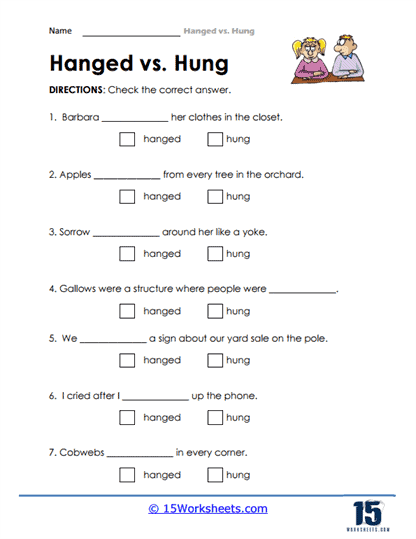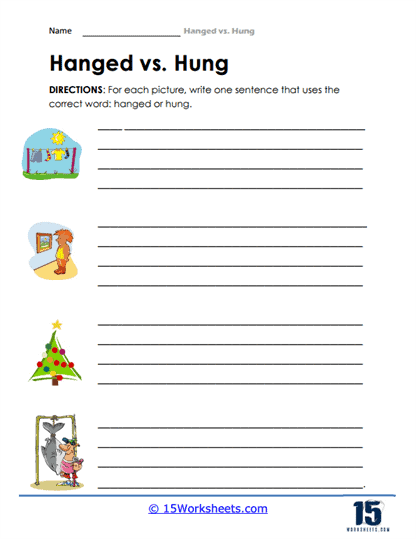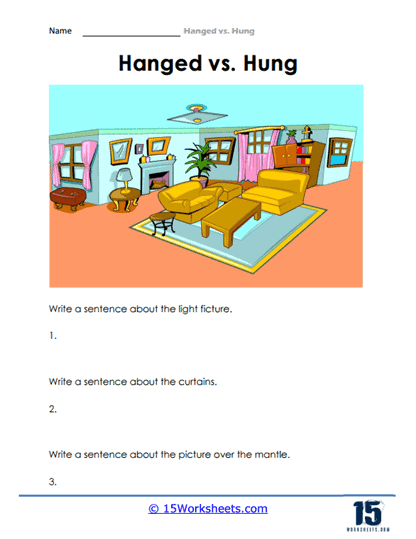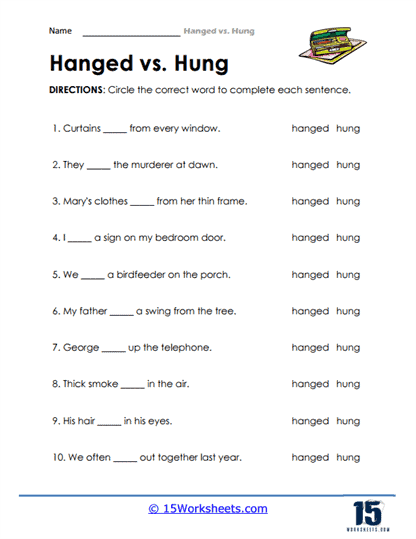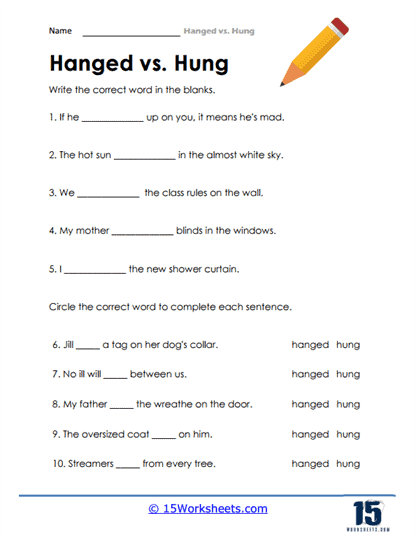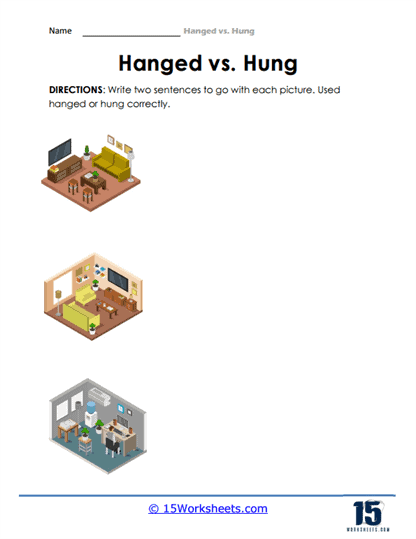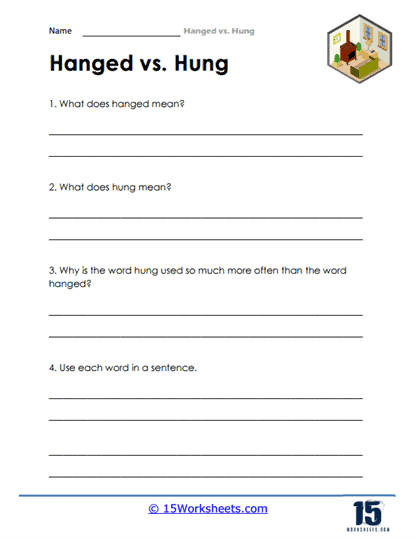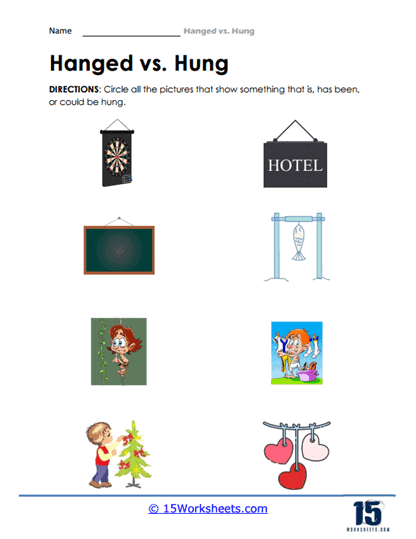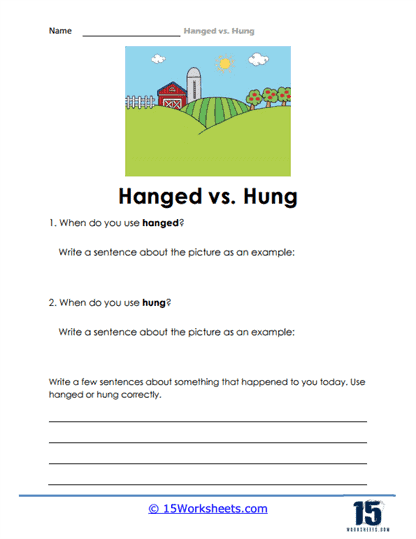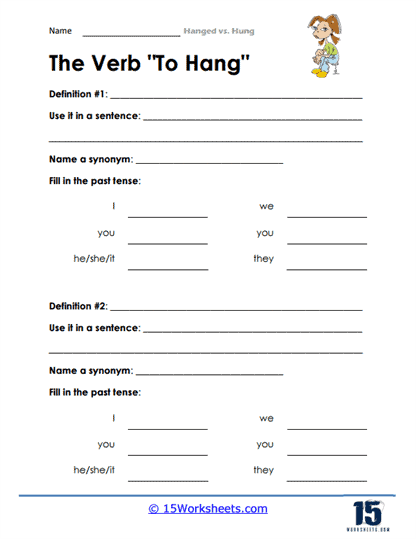Hang vs. Hung Worksheets
About These 15 Worksheets
These worksheets will help students understand the correct usage of the verbs “hang” and “hung” in the English language. These worksheets are particularly useful for learners grappling with the complexities of English verb forms, specifically the past tense and past participles. The worksheets encompass various types of exercises, each targeting different aspects of language learning, including grammar understanding, context usage, and writing skills.
Through a variety of exercises, they address different learning needs and styles, making them suitable for a wide range of learners. The consistent practice provided by these worksheets not only sharpens grammar skills but also contributes to overall language proficiency. By focusing on common verbs like “hang” and “hung,” these worksheets offer a focused approach to learning English, which is beneficial for students at all levels of language proficiency.
Types of Exercises Found On Worksheets
Fill-in-the-Blank Exercises – These exercises present sentences with missing words, where students must choose between “hang” and “hung” to correctly complete the sentence. For example, “She _____ her coat on the rack.” This exercise type helps students practice verb usage in context.
Sentence Correction Exercises – Students are given sentences with incorrect usage of “hang” or “hung” and are asked to correct them. This helps in recognizing and rectifying common mistakes.
Matching Exercises – These exercises might involve matching sentences with the correct form of the verb or matching sentence halves, one with “hang” and the other with “hung,” to form a coherent statement.
Multiple Choice Questions – Students are presented with a sentence and several verb form options. They must select the correct form. This exercise is beneficial for testing quick decision-making skills in grammar.
Verb Conjugation Tables – Students fill in tables with the correct forms of “hang” in various tenses, aiding in understanding verb conjugations comprehensively. Longer passages where students must use the correct form of “hang” or “hung” in various places. This enhances understanding in a more narrative context.
Dialogue Exercises – Students fill in dialogues with the correct verb forms, simulating real-life conversational scenarios.
The Benefit of These Worksheets
Improved Grammar Understanding – Regular practice with these worksheets deepens the understanding of verb tenses, particularly the past tense and past participle forms. This is fundamental in mastering English grammar.
Contextual Learning – By using verbs in various sentences and contexts, students learn not just the verb forms but also how their usage changes with context. This enhances their ability to comprehend and use English in real-life situations.
Error Correction and Recognition – Exercises that involve correcting mistakes allow students to recognize common errors and learn how to avoid them, which is crucial in writing and speaking correctly.
Enhanced Writing Skills – As students become more proficient in using verbs correctly, their overall writing skills improve. Proper verb usage makes writing clearer, more precise, and grammatically sound.
Vocabulary Expansion – While the primary focus is on “hang” and “hung,” these worksheets often introduce other vocabulary words, thereby broadening the student’s English vocabulary.
Confidence Building – Mastery of verb forms builds confidence in using the language, encouraging students to engage more in English conversations and writing.
Test Preparation – These worksheets can be an excellent tool for preparing for English language tests, which often assess grammar and verb usage.
How to Use Hang vs. Hung Grammatical
The words “hang” and “hung” are both forms of the same verb, but they are used in different grammatical contexts in the English language. Understanding their proper usage is essential for grammatical accuracy.
Hang (Present Tense and Base Form)
Usage: “Hang” is used as the base form and the present tense of the verb. It is employed when referring to the present or future actions. In the case of forming the present continuous tense, “hang” is used with helping verbs like “is” or “are.”
Example: “Please hang your coat on the rack.” (Here, “hang” is used in the present tense to indicate a current action.)
Hung (Simple Past Tense and Past Participle for Intransitive Use):
Usage: “Hung” is commonly used as the simple past tense and past participle of “hang” when the verb is used intransitively (without a direct object) and refers to the action of something being suspended or attached from above.
Example: “The picture hung on the wall for years.” (In this sentence, “hung” is used as the simple past tense, describing an action that happened in the past.)
It’s important to note that “hang” has another past participle form, “hanged,” which is specifically used in a legal or formal context when referring to death by hanging.
Example (using “hanged”): “The criminal was hanged at dawn.” (Here, “hanged” is the correct past participle form when referring to execution by hanging.)
In everyday usage, “hung” is the more commonly used past participle form for all general meanings of “hang” except in the context of execution. Understanding these distinctions and their proper contexts is crucial for correct grammatical usage.




